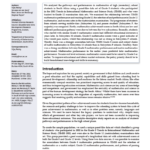Educational outcomes: Pathways and performance in South African high schools

We analysed the pathways and performances in mathematics of high (secondary) school students in South Africa using a panel-like data set of Grade 8 students who participated in the 2002 Trends in International Mathematics and Science Study (TIMSS) and who were tracked to Grade 12 examination data sets. We examined the relationship between TIMSS mathematics performance and reaching Grade 12, the selection of and performance in Grade 12 mathematics, and success rates in the matriculation examination. The progression of students from schools serving middle-class (Subsystem M) and poorer students (Subsystem P, the majority) was compared. Firstly, mathematics achievement scores in South Africa are low and different performance patterns were shown between the two subsystems. Secondly, students who started with similar Grade 8 mathematics scores had different educational outcomes 4 years later. In Subsystem M schools, Grade 8 mathematics scores were a good indicator of who would pass matric, whilst this relationship was not as strong in Subsystem P schools. Thirdly, there was a stronger association between TIMSS Grade 8 scores and subject choice of matric mathematics in Subsystem M schools than in Subsystem P schools. Fourthly, there was a strong correlation between Grade 8 mathematics performance and matric mathematics achievement. Mathematics performance in the earlier years predicted later mathematics performance. To raise exit level outcomes, mathematics scores need to be raised by Grade 8 or earlier. To improve educational and labour market outcomes, the policy priority should be to build foundational knowledge and skills in numeracy.
